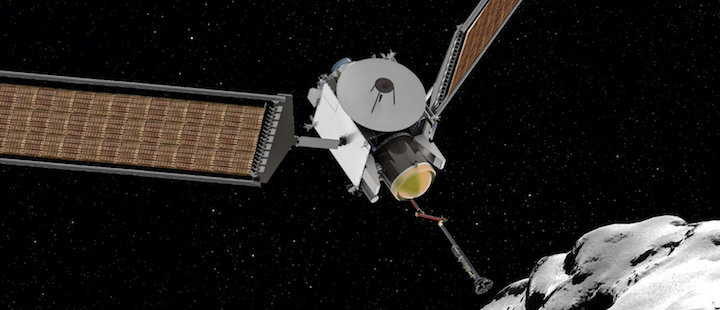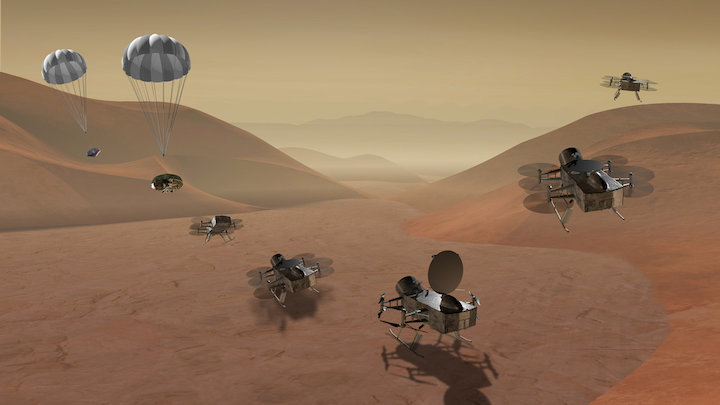23.03.2018

One of two missions competing to launch under NASA's New Frontiers program is the Comet Astrobiology Exploration Sample Return Mission (CAESAR). This spacecraft would launch to Comet 67P/Churyumov-Gerasimenko in 2024, scoop up a small sample of comet dust and pebbles from its surface, and return the sample to Earth in 2038.
-
HE WOODLANDS, Texas — Should NASA send a quadcopter to explore the Saturn moon Titan, or launch a spacecraft to fetch a sample from a comet? Only one of these space missions will be selected to launch in the mid-2020s, and the competition is on as the two science teams strive to make a compelling case for their out-of-this-world ideas.
The two mission concepts were selected from 12 proposals as the finalists for NASA's New Frontiers program, which conducts medium-cost robotic space exploration missions (like Juno and New Horizons) capped at $1 billion.
After NASA announced the finalists in 2017, the agency awarded both teams funding to further develop their ideas. Their final proposals are due in December, and NASA will announce the winner next summer, NASA Planetary Science Director Jim Green said at a news conference here at the Lunar and Planetary Science Conference.
One of the proposed missions, called Dragonfly, aims to send a quadcopter to Saturn's largest moon, Titan. NASA's Cassini mission and the European Space Agency's Huygens probe have shown that Titan could potentially host extraterrestrial life, and Dragonfly would further explore that possibility. Its design would enable it to both fly around in Titan's atmosphere and land on its surface. "This particular vehicle has the opportunity to make many hops and move to several locations and continue on with its chemical analysis," Green said.
The other proposed mission is the Comet Astrobiology Exploration Sample Return Mission (CAESAR). This mission would send a spacecraft "to an old friend," Comet 67P, "a fabulous comet we probably know the most about because of Rosetta," Green said. (Rosetta was a European Space Agency spacecraft that studied Comet 67P from 2014 to 2016.) Much like NASA's OSIRIS-REx mission to an asteroid, CAESAR would scoop up a sample without landing on the comet and return approximately 2.8 ounces (80 grams) of comet dust to Earth.

Another NASA mission concept competing for the opportunity to launch in 2024 or 2025 is Dragonfly, a robotic rotorcraft that would explore Saturn's largest moon, Titan.
-
While the Dragonfly mission would be the first of its kind in that it would fly a drone on another world, NASA has done a comet-sample-return mission before. The Stardust mission brought back samples of Comet Wild 2 in 2006. However, Green pointed out that a comet-sample-return mission has been an important priority in the decadal survey, a publication by the National Academy of Sciences that guides NASA's decisions when it comes to selecting missions.
For the rest of the year, the Dragonfly and CAESAR teams will be working hard to fine-tune their mission plans by "taking input from evaluations, mitigating risks and coming up with ways that they can improve their proposals," Green said. The winning team will see their mission launch in 2024 or 2025. May the best mission win!
Quelle: SC
